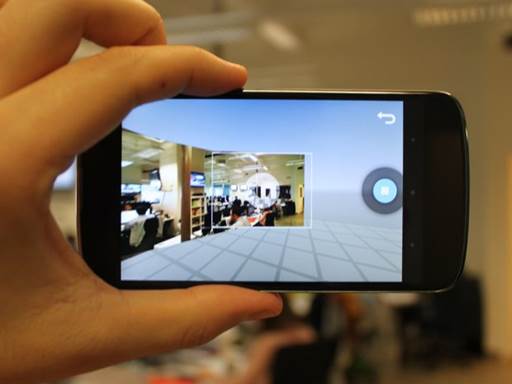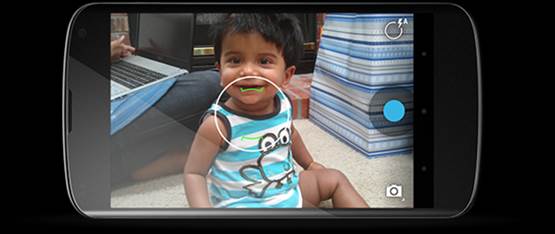Camera
We admit for always setting highest
expectation to the Nexus devices – each device always carries a burden which is
the newest high-class Android phone, and they are put forth by Google as an
example for other Android manufacturers. That’s the reason we are incredibly
disappointed about the decision of Samsung last year, which included a 5MP
sensor in Galaxy Nexus. A year later, LG has ensured to mount the 8MP camera
onto Nexus 4. On the spec sheet, it’s not the best thing on the market – but
you should remember, the MP number never tells you the whole story. However,
before we go too far, let’s discuss about the sure interface in the camera app.
Though you have used the Android devices before, UI of Nexus 4 can make you
confuse at first. It’s very basic at a glance, only including a viewfinder and
a sidebar with shutter button, settings button and the switch for camera modes.
When choosing settings (that can also be selected by holding the viewfinder),
you will be presented a large circle with many options arranging outside of it.
Just need to drag the finger to each option and you will be shown more options;
you can also pinch-to-zoom 4-fold on the viewfinder. You can also be
panic-stricken by the lack of thumbnail of gallery, but don’t panic – just need
to swipe to the right and your gallery will pop up, one gesture identical to iOS
or Windows Phone, which allows you to swipe to the right to have the same
result. Exposure and focus lock are also available by hitting and holding the
screen. We wish we can say that the camera of Nexus 4 is beautified with every
decoration (let’s think about the settings list you have on Galaxy S III), but
the selection is pretty limited here: HDR is now naturally supported, and you
can also adjust white balance, choose one out of 4 scene mode and change
resolution as well as flash settings. Panorama mode also reappears. That’s all.
If you want any other smart filter for Nexus, you may want to start checking to
see what options are available on Play Store – luckily, there are plenty to
choose.

It’s
very basic at a glance, only including a viewfinder and a sidebar with shutter
button, settings button and the switch for camera modes
There’s another skillful camera mode that
you can take advantages with Android 4.2, that’s Photo Sphere. You can call it
a type of “Panoramic Mode 2.0” – instead of taking photos horizontally, you can
add another dimension by shooting vertically. Then, after a 1 or 2 minutes combining,
your photo is ready to view and it appears with the curvature as a natural
sphere; when looking at the last product, you will have the feeling that you’re
actually looking from the left to the right as if you were actually there – normally
you need to scroll around the whole images to view all, which increase the
impressed depth for our landscape photos. With an even better feature, the
phone can carry out the scrolling for you so that you can sit and enjoy the
scenery. There’s one complaint: we realize that the phone has some problem when
combining the images together. In a photo, the right half of a window is
noticeably higher (and there’s more reasonable exposure) than the left half, a
frame looks as if it’s sawed into half and one side of the bookshelf has more
exposure than the other side. This problem mainly relates more to firmware,
because we have realized the same problems on Nexus 10 made by Samsung. We hope
to see this thing solved in a 4.2.x future update. Now let’s turn attention out
of the software and step into the camera performance section. As mentioned
before, the newest Nexus is not what we call an “extreme” in photography field,
so does this year’s model have any difference? The answer is yes – in a good
manner.

There’s
another skillful camera mode that you can take advantages with Android 4.2,
that’s Photo Sphere
We have performed some benchmarks with Nexus
4 and Galaxy S III, one of the best 8MP portable cameras we used to feel
interested when using. There’re some fields that Nexus 4 defeat GS3, and in
other fields it’s still good, but falls behind the Samsung rival. Nexus seems
better in close-up shots and when zooming at full volume. We also prefer HDR on
Nexus. However, colors seem to be more naturally saturated on GS3, and the sky
shows more realistic blue. The LED flash on Nexus is very bright – in fact,
it’s almost too bright. This is a rare problem on smartphone, but many shots
taken with flash are washed out. If comparing, flash of GS3 is more faded, but
at least we can see all colors in the way they’re supposed to be. In general,
the lowlight performance is easily acceptable on Nexus, but we see a lot of
noise and less light than GS3.

In
general, the lowlight performance is easily acceptable on Nexus, but we see a
lot of noise and less light than GS3.
Finally, the shooting speed seems to be
different, depending on which it needs to focus before the images is taken, but
it still appears less than 2 seconds in most time. There are several times our
theme is washed-out because they move before we can be able to finish shooting.

Images
taken with Nexus 4 camera
In general, it’s not the best performer
among the peers, but the camera is still a precious asset for Nexus 4, while
it’s a loss for the predecessor of this phone. And that’s exactly what we’re
expecting to see. While we always love to have the best performance if
possible, we’re very “picky” in that respect – it’s good to see a lot of love
and attention for this aspect of the Nexus family.

In
general, it’s not the best performer among the peers, but the camera is still a
precious asset for Nexus 4
Camcorder can record 1,080p films in MPEG-4
format, and record films with an average of 22fps with the bit speed of 9Mbps. This
leads to the noisy, quite choppy videos that don’t actually convince us that
what we’re watching is the true HD quality. A positive notification is that you
can be able to shoot at the same time of recording videos, pretty similar to
what you can do on Galaxy Nexus.

Camcorder
can record 1,080p films in MPEG-4 format